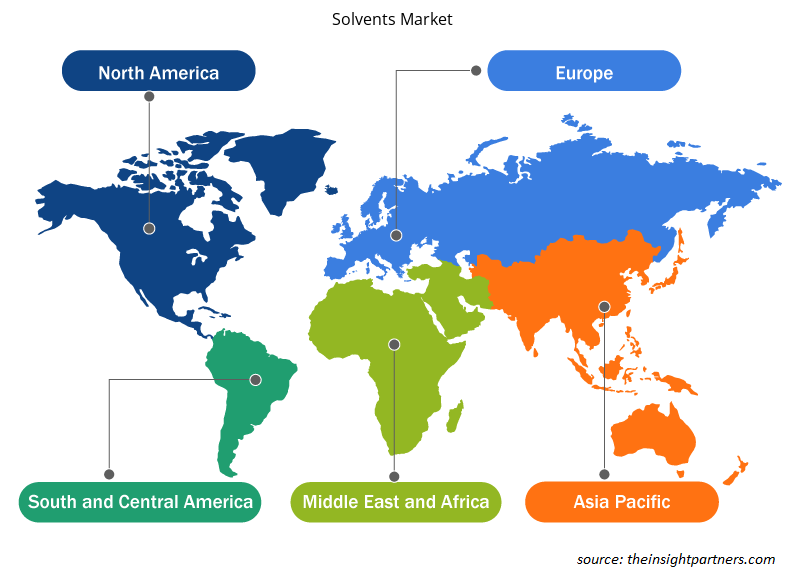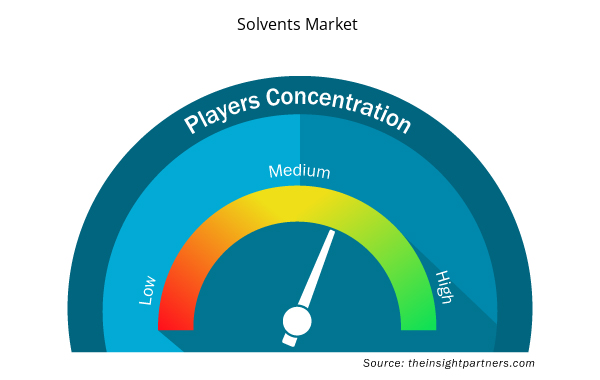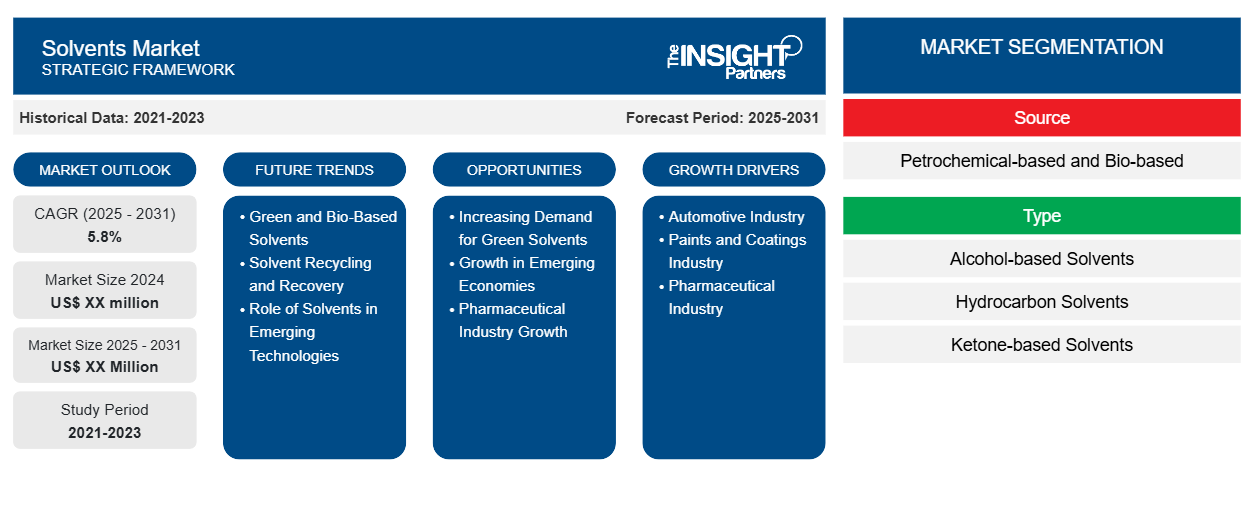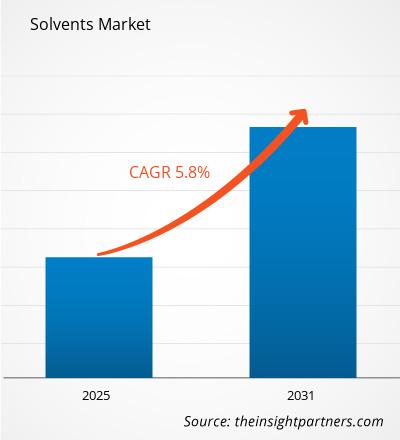Le marché des solvants devrait enregistrer un TCAC de 5,8 % de 2024 à 2031, avec une taille de marché passant de XX millions USD en 2024 à XX millions USD d'ici 2031.
Le rapport est segmenté par source (à base de produits pétrochimiques et biosourcés). Le rapport présente en outre une analyse basée sur le type (solvants à base d'alcool, solvants hydrocarbonés, solvants à base de cétone, esters, solvants chlorés et autres). Le rapport est en outre segmenté par application (peintures et revêtements, produits pharmaceutiques, produits agrochimiques, adhésifs, soins personnels et cosmétiques, produits chimiques, caoutchoucs et autres). Le rapport couvre cinq régions : l'Amérique du Nord, l'Europe, l'Asie-Pacifique, le Moyen-Orient et l'Afrique, l'Amérique du Sud et l'Amérique centrale et les principaux pays de chaque région. L'analyse mondiale est ensuite décomposée au niveau régional et par principaux pays. Le rapport offre la valeur en USD pour l'analyse et les segments ci-dessus.
Objectif du rapport
Le rapport Solvents Market de The Insight Partners vise à décrire le paysage actuel et la croissance future, les principaux facteurs moteurs, les défis et les opportunités. Cela fournira des informations à diverses parties prenantes commerciales, telles que :
- Fournisseurs/fabricants de technologie : pour comprendre l’évolution de la dynamique du marché et connaître les opportunités de croissance potentielles, leur permettant de prendre des décisions stratégiques éclairées.
- Investisseurs : Effectuer une analyse complète des tendances concernant le taux de croissance du marché, les projections financières du marché et les opportunités qui existent tout au long de la chaîne de valeur.
- Organismes de réglementation : Réglementer les politiques et surveiller les activités du marché dans le but de minimiser les abus, de préserver la confiance des investisseurs et de maintenir l’intégrité et la stabilité du marché.
Segmentation du marché des solvants
Source
- À base de produits pétrochimiques et biosourcés
Taper
- Solvants à base d'alcool
- Solvants à base d'hydrocarbures
- Solvants à base de cétone
- Esters
- Solvants chlorés
Application
- Peintures et revêtements
- Médicaments
- Produits agrochimiques
- Adhésifs
- Soins personnels et cosmétiques
- Produits chimiques
- Caoutchoucs
Géographie
- Amérique du Nord
- Europe
- Asie-Pacifique
- Amérique du Sud et Amérique centrale
- Moyen-Orient et Afrique
Personnalisez ce rapport en fonction de vos besoins
Vous bénéficierez d'une personnalisation gratuite de n'importe quel rapport, y compris de certaines parties de ce rapport, d'une analyse au niveau des pays, d'un pack de données Excel, ainsi que de superbes offres et réductions pour les start-ups et les universités.
- Obtenez les principales tendances clés du marché de ce rapport.Cet échantillon GRATUIT comprendra une analyse de données, allant des tendances du marché aux estimations et prévisions.
Facteurs de croissance du marché des solvants
- Industrie automobile : Le marché des solvants est généralement fortement impacté par les industries de fabrication de produits chimiques. Les solvants jouent un rôle important dans de nombreuses applications ; ils contribuent de manière significative à tous les processus industriels impliquant des synthèses chimiques, des revêtements, des peintures, des adhésifs, des plastiques, des produits pharmaceutiques et d'autres produits de soins personnels. Avec l'expansion des industries, en particulier dans les économies en développement, la demande de solvants utilisés dans la formulation de produits chimiques va très probablement augmenter. Les solvants impliquent la facilitation des exigences de propriétés telles que la viscosité réduite, la dissolution et la dispersion, ce qui crée leur demande dans de nombreuses industries.
- Industrie des peintures et des revêtements : Les deux principales industries qui utilisent le plus de solvants sont l'automobile et les peintures et revêtements. Les peintures, apprêts et finitions automobiles utilisent des solvants pour la durabilité, la cohérence des couleurs et la résistance aux forces environnementales. La demande de revêtements et de peintures hautes performances, qui augmente avec la hausse de la production automobile, et la tendance croissante à la finition automobile alimentent également ce marché. De même, dans la personnalisation des véhicules, une tendance qui se poursuit, la hausse de la demande de revêtements écologiques de haute qualité rend le marché des solvants d'autant plus important. Même la croissance des projets de construction et d'infrastructures fait augmenter la demande de peintures et de revêtements, ce qui entraîne une augmentation des consommateurs de solvants.
- Industrie pharmaceutique : Les industries pharmaceutiques et de soins personnels sont parmi les plus grandes consommatrices de solvants utilisés dans la formulation de médicaments, de cosmétiques et de produits de soins personnels. La demande de produits pharmaceutiques, notamment de vaccins, de pommades et de médicaments oraux, augmente avec le vieillissement de la population mondiale et des solvants de haute pureté sont nécessaires. Dans les soins personnels, les solvants apparaissent dans une large gamme de formulations, des soins de la peau et des cheveux aux parfums et aux produits de maquillage. En dehors de cela, la demande croissante de produits pharmaceutiques et de soins personnels, en particulier dans les économies émergentes, a été un catalyseur de la croissance du marché des solvants.
Tendances futures du marché des solvants
- Solvants verts et biosourcés : De plus, l’intérêt croissant pour les questions environnementales et les COV et la réglementation en vigueur ont conduit à la tendance vers les solvants verts et biosourcés. Traditionnellement, ils sont produits à partir de sources renouvelables : huiles végétales, maïs ou soja. Ils offrent donc une nouvelle classe de solvants conçus pour être moins toxiques et moins riches en COV que les solvants traditionnels à base de produits pétrochimiques. Cette tendance est également alimentée par la demande des consommateurs pour des produits verts et par les pressions réglementaires visant à réduire la pollution environnementale et à améliorer la sécurité au travail. Les principales gammes de produits contenant ces solvants verts sont les peintures et revêtements, les adhésifs et les agents de nettoyage.
- Recyclage et récupération des solvants : une autre façon de soutenir la tendance à la durabilité sur le marché des solvants est de recourir aux technologies de recyclage et de récupération des solvants. Les tendances indiquent que les secteurs de l'automobile, de la chimie, des peintures et des revêtements dépendent de plus en plus de solvants frais en adoptant des technologies de recyclage qui peuvent réutiliser les solvants dans le processus de fabrication. La base d'un tel changement est environnementale : c'est-à-dire en raison de la réduction des déchets et des émissions nocives dans l'environnement. Elle est également liée aux coûts : elle permet d'économiser les coûts des solvants frais. Les innovations dans les systèmes de récupération des solvants, ainsi que dans la distillation, améliorent l'efficacité de la réutilisation des solvants. Les entreprises qui cherchent à réduire les déchets et à économiser de l'argent sur la production trouvent le recyclage des solvants viable.
- Rôle des solvants dans les technologies émergentes : les solvants sont de plus en plus utilisés dans les technologies avancées et émergentes, notamment dans l’électronique, les batteries et les technologies des énergies renouvelables. Par exemple, dans la fabrication des batteries lithium-ion des véhicules électriques, les solvants sont utilisés pour synthétiser les électrolytes et disperser la matière active. La croissance de l’adoption des véhicules électriques et d’autres sources d’énergie renouvelables, telles que les panneaux solaires, entraîne une demande accrue de solvants. Dans la production de matériaux semi-conducteurs, de photovoltaïque et d’électronique à couches minces, les solvants jouent un rôle important ; ces domaines connaissent une croissance exponentielle, principalement en raison du développement de la recherche sur la technologie et de la demande de solutions beaucoup plus économes en énergie.
Opportunités du marché des solvants
- Demande croissante de solvants verts : Le marché des solvants verts semble avoir de grandes chances de croissance car la société et les industries demandent déjà une alternative durable à l’utilisation de solvants traditionnels à base de pétrole. La demande croissante de pratiques industrielles respectueuses de l’environnement motive l’utilisation de solvants verts. Alors que les gouvernements du monde entier commencent à réglementer les émissions de COV en imposant des réglementations plus strictes, la demande de solvants biosourcés et à faible toxicité va continuer à croître. Les entreprises qui fabriquent et vendent des solvants biosourcés bénéficieront de cette tendance en proposant des options vertes dans diverses industries d’utilisateurs finaux comme les peintures et revêtements, les adhésifs, les agents de nettoyage et les produits pharmaceutiques.
- Croissance dans les économies émergentes : Le marché des solvants offre d’importantes opportunités de croissance dans les économies émergentes, notamment en Asie-Pacifique, en Amérique latine et en Afrique, où l’industrialisation et l’urbanisation s’accélèrent. Par exemple, les secteurs de la chimie, de l’automobile et de la fabrication, qui constituent les plus gros consommateurs de solvants, connaissent une croissance rapide dans des pays comme la Chine et l’Inde. À mesure que la base et les infrastructures de ces régions continuent de s’étendre, les besoins en revêtements, peintures, adhésifs et produits pharmaceutiques et leurs solvants correspondants auront tendance à augmenter. En outre, les réglementations en matière de sécurité et d’impact environnemental se renforceront à mesure que ces économies arriveront à maturité ; la demande de solvants hautement avancés, peu toxiques et respectueux de l’environnement continuera d’augmenter.
- Croissance de l'industrie pharmaceutique : Le marché pharmaceutique, principalement celui de la fabrication de médicaments injectables, de vaccins et de produits biologiques, représente une autre opportunité cruciale pour les solvants. Les formulations pharmaceutiques nécessitant des solvants de haute pureté englobent les solvants dans les systèmes d'administration de médicaments, les formulations et les produits stériles. Alors que le scénario mondial des soins de santé s'améliore, en grande partie en raison des maladies chroniques et du vieillissement de la population ainsi que du besoin croissant de thérapies médicamenteuses complexes, la demande de solvants spécialisés dans les industries pharmaceutiques va également augmenter. Ainsi, les entreprises ayant la capacité de répondre à cette demande de solvants de haute qualité, sûrs et conformes à la réglementation auront un grand potentiel de marché dans ce domaine.
Aperçu régional du marché des solvants
Les tendances régionales et les facteurs influençant le marché des solvants tout au long de la période de prévision ont été expliqués en détail par les analystes d’Insight Partners. Cette section traite également des segments et de la géographie du marché des solvants en Amérique du Nord, en Europe, en Asie-Pacifique, au Moyen-Orient et en Afrique, ainsi qu’en Amérique du Sud et en Amérique centrale.

- Obtenez les données régionales spécifiques au marché des solvants
Portée du rapport sur le marché des solvants
| Attribut de rapport | Détails |
|---|---|
| Taille du marché en 2024 | XX millions de dollars américains |
| Taille du marché d'ici 2031 | XX millions de dollars américains |
| Taux de croissance annuel composé mondial (2025-2031) | 5,8% |
| Données historiques | 2021-2023 |
| Période de prévision | 2025-2031 |
| Segments couverts | Par source
|
| Régions et pays couverts | Amérique du Nord
|
| Leaders du marché et profils d'entreprises clés |
|
Densité des acteurs du marché des solvants : comprendre son impact sur la dynamique des entreprises
Le marché des solvants connaît une croissance rapide, tirée par la demande croissante des utilisateurs finaux en raison de facteurs tels que l'évolution des préférences des consommateurs, les avancées technologiques et une plus grande sensibilisation aux avantages du produit. À mesure que la demande augmente, les entreprises élargissent leurs offres, innovent pour répondre aux besoins des consommateurs et capitalisent sur les tendances émergentes, ce qui alimente davantage la croissance du marché.
La densité des acteurs du marché fait référence à la répartition des entreprises ou des sociétés opérant sur un marché ou un secteur particulier. Elle indique le nombre de concurrents (acteurs du marché) présents sur un marché donné par rapport à sa taille ou à sa valeur marchande totale.
Les principales entreprises opérant sur le marché des solvants sont :
- BASF SE
- Société Exxon Mobil
- Dow Chemical
- Maruzen Pétrochimique Co., Ltd.
- Shell Global
Avis de non-responsabilité : les sociétés répertoriées ci-dessus ne sont pas classées dans un ordre particulier.

- Obtenez un aperçu des principaux acteurs du marché des solvants
Principaux arguments de vente
- Couverture complète : Le rapport couvre de manière exhaustive l’analyse des produits, des services, des types et des utilisateurs finaux du marché des solvants, offrant un paysage holistique.
- Analyse d’experts : Le rapport est compilé sur la base d’une compréhension approfondie des experts et analystes du secteur.
- Informations à jour : Le rapport garantit la pertinence commerciale en raison de sa couverture des informations récentes et des tendances des données.
- Options de personnalisation : ce rapport peut être personnalisé pour répondre aux exigences spécifiques du client et s'adapter parfaitement aux stratégies commerciales.
Le rapport de recherche sur le marché des solvants peut donc aider à ouvrir la voie au décodage et à la compréhension du scénario de l’industrie et des perspectives de croissance. Bien qu’il puisse y avoir quelques préoccupations valables, les avantages globaux de ce rapport ont tendance à l’emporter sur les inconvénients.
- Analyse historique (2 ans), année de base, prévision (7 ans) avec TCAC
- Analyse PEST et SWO
- Taille du marché Valeur / Volume - Mondial, Régional, Pays
- Industrie et paysage concurrentiel
- Ensemble de données Excel



Report Coverage
Revenue forecast, Company Analysis, Industry landscape, Growth factors, and Trends

Segment Covered
This text is related
to segments covered.

Regional Scope
North America, Europe, Asia Pacific, Middle East & Africa, South & Central America

Country Scope
This text is related
to country scope.
Questions fréquemment posées
The technological advancements in solvent recycling and recovery are expected to be the key market trend.
The report can be delivered in PDF/Word format, we can also share excel data sheet based on request.
On the basis of geography, the solvents market is classified into North America, Europe, Asia Pacific, Middle East and Africa, and South and Central America
BASF SE, Exxon Mobil Corp, Dow Inc, Honeywell International Inc, Huntsman International LLC, Celanese Corp, Shell Plc, TotalEnergies SE, KH Chemicals BV, and Gulf Chemical and industrial Oils Co
The major factors driving the solvents market are:
1. Growth in the Chemical Manufacturing Industry.
2. Expansion of the Automotive and Paints & Coatings Sectors.
The Solvents Market is estimated to witness a CAGR of 5.8% from 2023 to 2031
Trends and growth analysis reports related to Chemicals and Materials : READ MORE..
The List Of Companies
- BASF SE
- Exxon Mobil Corporation
- Dow Chemical
- Maruzen Petrochemical Co. ,Ltd.
- Shell Global
- Celanese Corporation
- Solvay S. A.
- INEOS
- Honeywell International Inc.
- Huntsman Corporation
The Insight Partners performs research in 4 major stages: Data Collection & Secondary Research, Primary Research, Data Analysis and Data Triangulation & Final Review.
- Data Collection and Secondary Research:
As a market research and consulting firm operating from a decade, we have published and advised several client across the globe. First step for any study will start with an assessment of currently available data and insights from existing reports. Further, historical and current market information is collected from Investor Presentations, Annual Reports, SEC Filings, etc., and other information related to company’s performance and market positioning are gathered from Paid Databases (Factiva, Hoovers, and Reuters) and various other publications available in public domain.
Several associations trade associates, technical forums, institutes, societies and organization are accessed to gain technical as well as market related insights through their publications such as research papers, blogs and press releases related to the studies are referred to get cues about the market. Further, white papers, journals, magazines, and other news articles published in last 3 years are scrutinized and analyzed to understand the current market trends.
- Primary Research:
The primarily interview analysis comprise of data obtained from industry participants interview and answers to survey questions gathered by in-house primary team.
For primary research, interviews are conducted with industry experts/CEOs/Marketing Managers/VPs/Subject Matter Experts from both demand and supply side to get a 360-degree view of the market. The primary team conducts several interviews based on the complexity of the markets to understand the various market trends and dynamics which makes research more credible and precise.
A typical research interview fulfils the following functions:
- Provides first-hand information on the market size, market trends, growth trends, competitive landscape, and outlook
- Validates and strengthens in-house secondary research findings
- Develops the analysis team’s expertise and market understanding
Primary research involves email interactions and telephone interviews for each market, category, segment, and sub-segment across geographies. The participants who typically take part in such a process include, but are not limited to:
- Industry participants: VPs, business development managers, market intelligence managers and national sales managers
- Outside experts: Valuation experts, research analysts and key opinion leaders specializing in the electronics and semiconductor industry.
Below is the breakup of our primary respondents by company, designation, and region:

Once we receive the confirmation from primary research sources or primary respondents, we finalize the base year market estimation and forecast the data as per the macroeconomic and microeconomic factors assessed during data collection.
- Data Analysis:
Once data is validated through both secondary as well as primary respondents, we finalize the market estimations by hypothesis formulation and factor analysis at regional and country level.
- Macro-Economic Factor Analysis:
We analyse macroeconomic indicators such the gross domestic product (GDP), increase in the demand for goods and services across industries, technological advancement, regional economic growth, governmental policies, the influence of COVID-19, PEST analysis, and other aspects. This analysis aids in setting benchmarks for various nations/regions and approximating market splits. Additionally, the general trend of the aforementioned components aid in determining the market's development possibilities.
- Country Level Data:
Various factors that are especially aligned to the country are taken into account to determine the market size for a certain area and country, including the presence of vendors, such as headquarters and offices, the country's GDP, demand patterns, and industry growth. To comprehend the market dynamics for the nation, a number of growth variables, inhibitors, application areas, and current market trends are researched. The aforementioned elements aid in determining the country's overall market's growth potential.
- Company Profile:
The “Table of Contents” is formulated by listing and analyzing more than 25 - 30 companies operating in the market ecosystem across geographies. However, we profile only 10 companies as a standard practice in our syndicate reports. These 10 companies comprise leading, emerging, and regional players. Nonetheless, our analysis is not restricted to the 10 listed companies, we also analyze other companies present in the market to develop a holistic view and understand the prevailing trends. The “Company Profiles” section in the report covers key facts, business description, products & services, financial information, SWOT analysis, and key developments. The financial information presented is extracted from the annual reports and official documents of the publicly listed companies. Upon collecting the information for the sections of respective companies, we verify them via various primary sources and then compile the data in respective company profiles. The company level information helps us in deriving the base number as well as in forecasting the market size.
- Developing Base Number:
Aggregation of sales statistics (2020-2022) and macro-economic factor, and other secondary and primary research insights are utilized to arrive at base number and related market shares for 2022. The data gaps are identified in this step and relevant market data is analyzed, collected from paid primary interviews or databases. On finalizing the base year market size, forecasts are developed on the basis of macro-economic, industry and market growth factors and company level analysis.
- Data Triangulation and Final Review:
The market findings and base year market size calculations are validated from supply as well as demand side. Demand side validations are based on macro-economic factor analysis and benchmarks for respective regions and countries. In case of supply side validations, revenues of major companies are estimated (in case not available) based on industry benchmark, approximate number of employees, product portfolio, and primary interviews revenues are gathered. Further revenue from target product/service segment is assessed to avoid overshooting of market statistics. In case of heavy deviations between supply and demand side values, all thes steps are repeated to achieve synchronization.
We follow an iterative model, wherein we share our research findings with Subject Matter Experts (SME’s) and Key Opinion Leaders (KOLs) until consensus view of the market is not formulated – this model negates any drastic deviation in the opinions of experts. Only validated and universally acceptable research findings are quoted in our reports.
We have important check points that we use to validate our research findings – which we call – data triangulation, where we validate the information, we generate from secondary sources with primary interviews and then we re-validate with our internal data bases and Subject matter experts. This comprehensive model enables us to deliver high quality, reliable data in shortest possible time.


 Obtenez un échantillon gratuit pour ce rapport
Obtenez un échantillon gratuit pour ce rapport